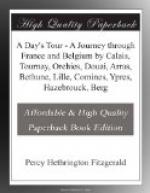This old town has other curious things to exhibit, such as the enormous old Abbey of St. Vaast—with its huge expansive roof, which somehow seems to dominate the place, and thrusts forward some fragment or other—where a regiment might lodge. Its spacious gardens are converted to secular uses. Then I find myself at the old-new cathedral, begun about a century ago, and finished about fifty years since—a ‘poorish’ heartless edifice in the bald Italian manner, and quite unsuited to these old Flemish cities. I come out on a terrace with a huge flight of steps which leads to a lower portion of the city. This, indeed, leads down from the haute to the basse ville; and it is stated that a great portion of this upper town is supported upon catacombs or caves from which the white stone of the belfry and town-hall was quarried. It is a curious feeling to be shown the house in which Robespierre was born, which, for the benefit of the curious it may be stated, is to be found in the Rue des Rapporteurs, close to the theatre. Arras was a famous Jacobin centre, and from the balcony of this theatre, Lebon, one of the Jacobins, directed the executions, which took place abundantly on the pretty place.
[Illustration: BETHUNE.]
Thus much, then, for Arras, where one would have liked to linger, nay, to stay a week or a few days. But this wishing to stay a week at a picturesque place is often a dangerous pitfall, as the amiable Charles Collins has shown in his own quaint style. Has anyone, he asks, ever, ’on arriving at some place he has never visited before, taken a sudden fancy to it, committed himself to apartments for a month certain, gone on praising the locality and all that belongs to it, ferreting out concealed attractions, attaching undue importance to them, undervaluing obvious defects: has he gone on in this way for three weeks,’ or rather three days, ’out of his month, then suddenly broken down, found out his mistake, and pined in secret for deliverance?’ So it would be, as I conceive, at Bruges, or perhaps at St. Omer. There you indeed appreciate the dead-alive city ’in all its quiddity.’ But a few days in a ‘dead-alive’ city, were it the most picturesque in the world, would be intolerable.
By noon, when the sun has grown oppressively hot, I find myself set down at a sort of rural town, once flourishing, and of some importance—Bethune. A mile’s walk on a parched road led up the hill to this languishing, decayed little place. It had its forlorn omnibus, and altogether suggested the general desolation of, say, Peterborough. Had it remained in Flemish hands, it would now have been flourishing. I doubt if any English visitor ever troubles its stagnant repose. Yet it boasts its ‘grand’ place, imposing enough as a memorial of departed greatness, and, as usual, a Flemish relic, in the shape of a charming belfry and town-hall combined. It was really truly ‘fantastical’ from the airiness of its little cupolas and galleries, and was in tolerable order. Like the old Calais watch-tower, it was caked round by, and embedded in, old houses, and had its four curious gargoyles still doing work.




